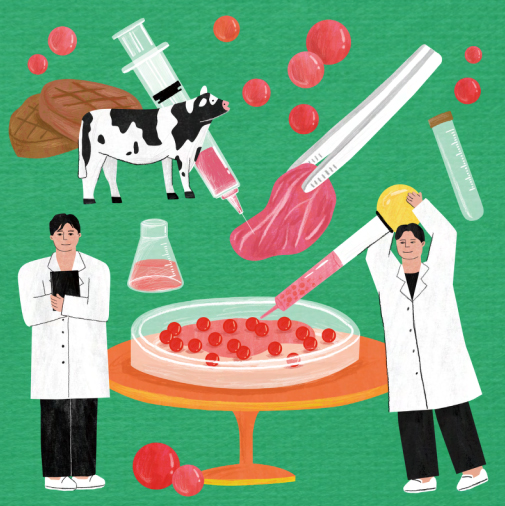Research
Note I
Cultured meat ushers in the era
of cellular agriculture
The present status and prospects for cultured meat, protein of the future

Livestock and poultry are leisurely roaming around the ranch in the distance. Every so often, their somatic cells are collected by a cell bank. Other than that, they lead peaceful lives and are then slaughtered. Next to the ranch are two factories, one that makes cell culture media and scaffolds and the other that grows a variety of plants used as raw materials for culture media. Village stores display traditional meat and cultivated meat side by side, and consumers choose depending on their preference. This represents the commercialization of cultured meat on which future humanity will thrive.
Cheorun Jo, Professor at Department of Food and Animal Biotechnology
I absolutely champion the consumption of traditional meat, a valuable food ingredient since primitive times, and the social contributions of the livestock industry that produces it. At the same time, I believe that cultured meat-related research will effectively address a range of issues such as food security and environmental problems that may arise from the skyrocketing demand for meat.
Humans need energy and nutrients for their survival. Compared to other food sources, meat is a nutritionally perfect food that contains a good balance of essential amino acids, essential fatty acids, and minerals such as iron and zinc, along with a high vitamin content. It is scientifically proven that humankind might not have survived many stages of evolution if not for meat. As such, meat is the most natural and valuable food that mankind has consumed for a longer period than any other food source.
There is a positive correlation between economic growth and meat consumption. According to a recent report, demand for meat in 2050 is projected to be double that of 2011. Is it possible to dramatically increase production and meet the sharp rise in demand for meat with current production methods? Probably not. Even maintaining the current level of production entails a host of problems that include greenhouse gases, energy consumption, and resource utilization from a global sustainability perspective. Furthermore, more ethically-minded consumers and the strong demand for animal welfare necessitate innovative alternatives.
Both the government and livestock industry are well aware of these developments and have redoubled their corresponding efforts to successfully navigate these issues. No feasible solutions are in sight, however. To overcome the inevitable limitations of traditional livestock and satisfy the rising demand for meat, the livestock industry has turned to eco-friendly, ethical, and more sustainable alternatives and put alternative proteins on the market as part of this attempt. Some published papers argue that alternative foods, such as plant and microorganism-based foods, edible insect protein, and cultured meat, can reduce greenhouse gas emissions and the use of water and land by more than 80%.
Cultured meat is an alternative food, produced by cultivating animalsвҖҷ muscle stem cells. Although cultured meat is an emerging technology area and has a long way to go in terms of stability verification and cost reduction, many have created high expectations for its contributions thanks to its resemblance to traditional meat. The production process can be briefly summarized as follows: Muscle stem cells are removed from an animalвҖҷs muscle; a cell culture medium is used as a nutrient to multiply the number of stem cells; stem cells are differentiated into muscle cells under specific conditions; and muscle cells are grown over a certain period of time, retrieved, processed as raw materials, and produced as a food similar to real meat. For this process, further research is needed to ensure safety as edible food and to ascertain the most efficient production process from an economic viewpoint.
Ancient alchemists strove to convert common metal into gold. A series of these efforts became the etymology of modern chemistry. In fact, lead iron was successfully turned into gold using a heavy iron accelerator. Led by Seoul National University, a joint research team, consisting of Sejong University, Space F, Daesang Corporation, and Lotte Fine Chemical, was born. Starting with the pilot project in 2020, the team was selected for the full-scale project in the Artificial Ecofood sector of the 2022 Industrial Technology Alchemist Project and will be conducting related research over the next five years. The joint team aims to formulate a standard model of cultured meat and to leverage innovative technology development to produce and commercialize safe cultured meat, thus securing the nationвҖҷs food sovereignty and leading the future global market.
Cellular agriculture is a new form of agriculture that utilizes cutting-edge biotechnology such as stem cells and tissue engineering to produce agricultural and livestock products through in vitro cell culture. A typical product of cellular agriculture technology is cultured meat, which is produced by in vitro cultures of livestock or fish cells. Moreover, the technology has enormous untapped potential in the fields of not only animal products like leather, fur, and milk, but also plant cultivation. The successful commercialization of cultured meat will certainly serve as a critical milestone in the paradigm shift from traditional agriculture to cellular agriculture.
Once again, I strongly support the consumption of traditional meat and the societal role of the livestock industry. However, it is time for us to pay serious attention to lab-grown meat to effectively address the issues of food security and environmental problems associated with the sudden increase in demand for meat. In short, we should take full advantage of these unfolding developments to elevate our technology to the next level and take center stage in the global arena.

